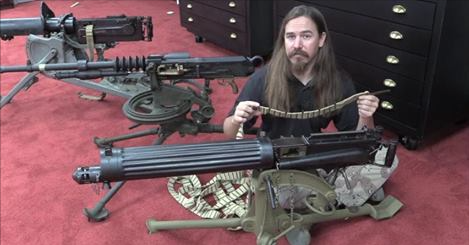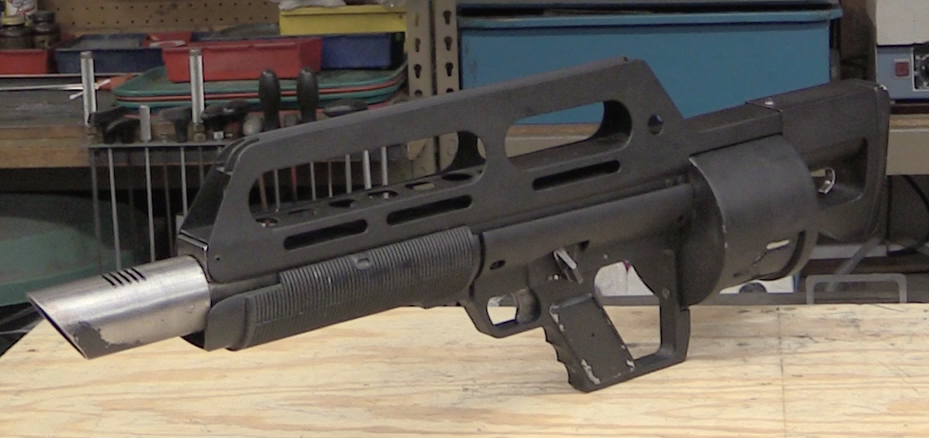The M6 Gun Motor Carriage was the first American tank destroyer of WWII – a 37mm antitank gun (basically identical to the M3 gun) mounted on the back of a Dodge 3/4 ton weapons carrier. A large armor shield protected the gun crew from small arm fire, but the vehicle was otherwise highly exposed. The truck was powered by a flathead 6-cylinder engine producing 99 horsepower, and had a top speed of 55 mph. The gun was effective and modern in the late 1930s when its design process began, but was underpowered and insufficient by the time the M6 first saw action in 1942/3 in Tunisia.
Not many complete M6 carriages remain in existence today, as they were replaced quickly after their poor showing in North Africa. Most had the guns removed and were converted back into utility trucks, while some were used by the Free French forces and some saw use in the Pacific theater (where the underpowered gun was less of a concern).




Thanks for showing another weapons that I knew nothing about and for the humor you added.
There are a few towed 37mm weapons displayed in parks in this area. One is in town here, but the other is about about 45 miles north of here and I think that one is a M3. I’ll have to go and have a look at both of them again.
The truck-mounted guns were also produced in other countries. For example Britsh Deacon http://en.wikipedia.org/wiki/Deacon_(artillery) but even if the more powerful gun is mounted the issue is the off-road mobility – it is inferior of tracked vehicles so either the trucks with gun will slow down the movement of group or either the tracked vehicles will “escape” from whelled part of unit.
I find it fascinating how quickly these late-thirties “state of the art” anti-tank weapons became obsolete in the face of advanced German armor. I guess it was better than nothing at the time, but not much (although the 37mm was pretty effective against infantry when loaded with anti-personnel rounds, particularly against the banzai charges on Guadalcanal). We have a couple of those old WW2 Dodge trucks rusting in our shop hangar right now. I am planning to restore one at some point, and this M6 conversion would make an interesting project. Thanks for the motivation, Ian. I think I’m going to head down there and get to work, even if it’s 110 in that damned hangar. Now, if I could only find an old 37mm gun lying around…
The US Army was especially unlucky since it entered the war relatively late, but had not updated its towed anti-tank guns. One reason for that was the US doctrine, which favored tank destroyers instead of towed anti-tank guns. Real tank destroyers just were not available for Operation Torch initially, so vehicles like the M6 GMC had to be substituted. While still a hasty stop-gap vehicle, the M3 Gun Motor Carriage with its 75mm gun mounted an armored half track was a considerably more viable in the anti-tank role. The US army also changed its opinion on towed AT guns during the North African campaign and decided to copy the British 6-pounder AT gun as the 57mm M1 AT gun. Ironically, the introduction of better tank destroyers (most notably the M10 “Wolverine”) and mass production of M4 tanks soon pushed the towed 57mm gun to a secondary role.
On a related note, many people also that the Browning .50 cal M2 HB heavy machine gun was originally considered an anti-tank weapon and in fact it would have been adequate against many early 1930s light tanks.
What Dodge truck was that, Ian? A “one-and-a-quarter ton”? Hmm, looks like a standar three-quarters WC to me, and according to the net resources it was:
“The WC55 Truck, 3/4 ton, 4×4 Gun Motor Carriage Dodge (G502) was a modified WC52 designed to carry an M3A1 37mm antitank gun and shield mounted on its cargo bed; the WC55 and gun combination was designated M6 Fargo Gun Motor Carriage (GMC) with 37mm Anti-tank Gun (G121). 5,380 built, most later dismantled and returned to service as WC52 cargo trucks.”
Here’s the roll call of the WC51 series;
WC51 Cargo truck
WC52 WC51 with winch on front bumper
WC53 Carryall (today we’d call it a 4×4 SUV)
WC54 Ambulance (some used by Signal Corps)
WC55 AT gun
WC56 Command reconnaissance vehicle (also known as the “Beep”- “Big Jeep”)
WC57 WC56 with winch on front bumper
WC58 Radio truck (purpose-built for Signal Corps)
WC59 Telephone repair truck (SC)
WC60 Mobile workshop similar to WC59 with more tool stowage
WC61 Light telephone repair truck- successor to WC59
WC62, WC63- 6×6 cargo trucks built on lengthened WC51 chassis
WC64 Ambulance, successor to WC54 with breakdown body to allow more to be carried in a transport for overseas deployment.
http://en.wikipedia.org/wiki/Dodge_WC_series
cheers
eon
The two we have are WC 52s. One had a jib added and was used as a yard tow for about 50 years. I just got back from looking at them and they aren’t in bad shape, all things considered. Most of the work would be cosmetic. The mechanical parts all seem solid.
Yep, it’s a 3/4 ton – I misspoke in the video and didn’t catch in time to correct.
The reason the shields were so small on most towed anti-tank guns is that their primary protection was to be as small and inconspicuous as possible. Preferably, they would be dug in and concealed. If given time to dig in the crew wouldn’t be relying only on the shield for protection any more than an infantryman would rely only on his helmet for protection from rifle fire. If the gun was well sited it would be very hard to spot, or if spotted, very hard to hit directly.
The safest way for tanks to deal with towed anti-tank guns would be to pull back and let artillery, mortars, or infantry deal with them. The high velocity (and often small) guns mounted on most tanks were not well suited to dealing with this sort of problem.
As soon as you mount the gun on a truck, all of the above goes out the window. It would be very difficult to hide and almost impossible to dig in. The tall shield would help with machine gun fire from the tanks, but the rest of the vehicle would be very vulnerable, quite easily costing the gun its mobility. Their vulnerability to supporting artillery would be horrific.
The British used what they called “portee” mounts, where they transported a normal towed gun on the back of a truck instead of towing it. However, they would normally dismount the gun from the truck when they got to their deployment area and use the gun from the ground with the truck moved back out of sight. Transporting the gun on the back of the truck simply gave them more mobility than conventional towing in certain types of terrain, such as North Africa.
I think the whole concept of permanently truck mounted anti-tank guns is questionable, except perhaps in very specialised circumstances.
One of my college profs was a Marine in the island campaign. He said that in their “special circumstances”, the WC55 was a useful “bunker buster”, because it could fit in places in banyan tangles that an M3 Stuart couldn’t.
His vote for the best support vehicle in such a squeeze, though, was the M3 Half-Track Gun Motor Carriage with the 75mm gun, or the (USMC-built) T12 GMC half-track with the 75mm or 105mm pack howitzer. They were better protected against small-arms fire than the M6, and their HE shells packed more punch. The M3 could also fire solid AP shot in event a Japanese tank showed itself (rare in the island battles). So could the M6, of course, but the 75mm hit with even more authority than the already pretty emphatic 37mm.
While both were underpowered for use against German armor by 1943, either one could take out a Japanese Type 93 “tankette” or Type 97 medium tank with a solid hit.
http://en.wikipedia.org/wiki/M3_Gun_Motor_Carriage
cheers
eon
In 1940 French army used in emergency some laffly-w15tcc with 47mm AT guns, too few, and too late (as usual)
http://www.chars-francais.net/new/index.php?option=com_content&task=view&id=107&Itemid=38
Interestingly, Osprey’s New Vanguard #11 has a tidbit about the fate of the 37mm guns used on M6s. At least some of them were installed on M2 half-tracks, with the US Army thus taking a page out of the Wehrmacht’s playbook (as the Germans also mounted 37mm guns on half-tracks). The book contains a photo of an M2 so fitted serving with the 2nd Armored Division in early 1944.
The U.S. army invented the “technical?”
An interesting aside; While stationed in Germany in the early 80’s my wife and I frequented a Guesthaus called the Tuefulskeller. The proprietor and his friends had all been captured at the Battle of Kasserine Pass. According to them, the defenses set by the Americans and the equipment used was absolutely fantastic! The effectiveness of our weapons against theirs was startling. It must be remembered that the Germans did not have very many tanks available and relied on lighter armored and unarmored vehicles for mast of the maneuver elements. The 37mm gun would have been just fine for that. What we deemed a failure they saw as well played. The group spent the rest of the war as POWs in NJ and signed Parole to work on the farms.
Cruachan!
Hi Jan
I saw your video abt. dodge wc 55 anti tank gun
I am now restoring one wc 55 but the gun shield is completely missing
Can you help me abt.it ?
Can you or someone provide some technical drawings etc in order to make a replica of the shield ?
Obviusly I will pay for it.
Pls. reply
Thanks
BR
Mattia
I’ve got a pair of 37mm breech rings with block (registered as DD’s under the NFA). I’m just looking to barrel them and find something to mount them in (preferably an M8 Greyhound). These are the M5 or M6 model (semi-automatic)
Where’s this “Fire in the Hole” BS come from? Any US tank or antitank crewman will tell you the gunner announces “On the way!” before pressing the trigger.
The WC51/52 was commonly known as the “Weapons Carrier” as their original job was to carry the Infantry Battalion’s Heavy Weapons Company’s four 81mm mortars and eight M1917A1 water cooled machine guns. THey later became a general utility vehicle – a military 3/4 ton pickup – and big brother to the quarter ton. The 1 1/2 ton W62/63
was employed as the prime mover for the Infantry Battalion’s AT Platoon’s and Regimental AT Company’s 57mm towed guns. The WC-51/52 was replaced by the M37 in Korea
which was replaced by M715 in Vietnam. My ROTC Detachment 1970-74 had a M715 on strength. The M715 was replaced by the M561 1 1/4 tonner in tactical units and commercial off the shelf pickups in support units
M37 https://en.wikipedia.org/wiki/Dodge_M37
M715 https://en.wikipedia.org/wiki/Kaiser_Jeep_M715